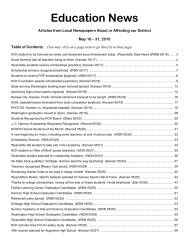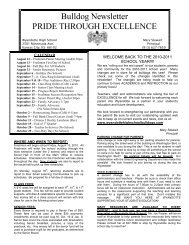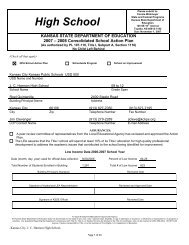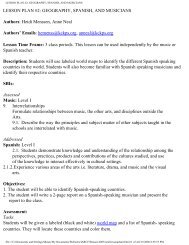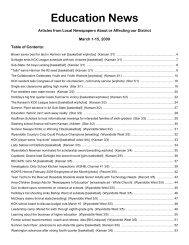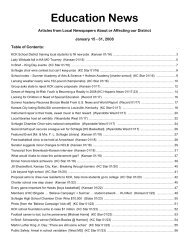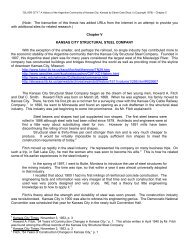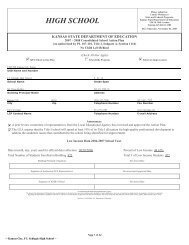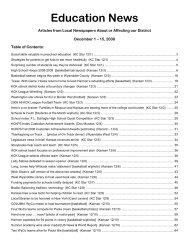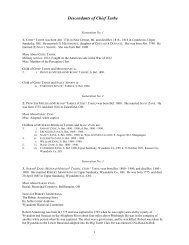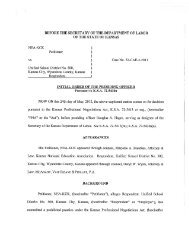Washington - Kansas City, Kansas Public Schools
Washington - Kansas City, Kansas Public Schools
Washington - Kansas City, Kansas Public Schools
Create successful ePaper yourself
Turn your PDF publications into a flip-book with our unique Google optimized e-Paper software.
Classroom teachers will begin administering diagnostic tests to students in August in preparation for the state assessment.<br />
The NWEA MAP will allow classroom teachers to identify strengths and weaknesses of the students within their SLCs.<br />
Through the use of the MAP, specific strengths and weaknesses in the areas of numbers & computation, algebra,<br />
geometry, and data are identified. All teachers of a student have access to the information in the MAP. Student progress is<br />
shared weekly with all staff within the SLC and the teachers then identify specific types of remediation that are content<br />
specific. As the diagnostic assessments, remediation, and dialogue continue, all SLC members know students' strengths<br />
and weaknesses and help students. Also, through the use of benchmark assessments within the math classes, and the<br />
sharing of this information with students, parents, advocates, and SLC teachers, all school members are responsible for<br />
talking with students around their progress.<br />
August & Early September<br />
MAP Assessments in reading and math for grades 9 and 10.<br />
MAP Information distributed to teachers and parents for each individual student.<br />
MAP Information studied in content team study sessions to identify weaknesses that are common within all students,<br />
within classes, and individual student weaknesses.<br />
Benchmark assessments begin in core content courses.<br />
Mid-Sept. -On-going<br />
Benchmarks assessments are continued and strengths and weaknesses of individual students, as well as classes of students,<br />
are identified. Strengths are celebrated and we use our content team time to identify ways to address the weaknesses of<br />
individual students. By the first week of September, Advocacy Advantage (a student tutoring program) has begun and<br />
teachers have recommended students.<br />
October<br />
Scrimmage Tests over assessed indicators that have been taught within the classroom are administered. Data is<br />
disaggregated by student and an item analysis is done. Teachers whose students outperformed others are asked to further<br />
share differences and observations of these classrooms by other teachers is set up. On-line formative assessments begin<br />
being used to assess instruction on tested indicators and to familiarize students with the format used on the state<br />
assessment and the tools available.<br />
November<br />
Benchmark assessments continue. On-line formative assessments continue. Content teams continue to focus on the results<br />
of assessments and what needs to change in instruction. Some students will begin state assessments at the end of<br />
November to mid-December.<br />
December - January<br />
MAP assessments are given again to students in grades 9 & 10 in math and reading and individual results are distributed to<br />
parents and teachers. Improvements are noted and we look for correlations to adjustments made in teaching. Scrimmage<br />
tests are given again to students over the assessed indicators that are taught within the content. These are very thoroughly<br />
studied during content team planning periods to identify specific weaknesses of individual students, interventions for these<br />
students, and new ways to teach concepts.<br />
February<br />
Instruction and assessment over benchmarks continues with reviews of student strengths included as bell work to refamiliarize<br />
students with skills previously covered. Interventions for students continue and teachers continue to explore<br />
new ways to teach/re-teach concepts students struggle with.<br />
March<br />
State assessments begin for sophomores and juniors. Freshmen in some instances are also assessed. With results from<br />
these, we will continue to tweak and study concepts.<br />
April - May<br />
Information provided from the state assessments continues to drive our instruction and we start looking toward revisions<br />
that need to be incorporated at a district level. Study groups continue along with interventions for students.<br />
<br />
Describe how professional development resources will be sufficient to effectively carry out the schoolwide reform<br />
strategies<br />
-- <strong>Kansas</strong> <strong>City</strong>, <strong>Washington</strong> High School --<br />
Page 32 of 50



